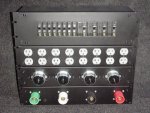Exactly right.... and nothing exists like what you describe.
In fact, what got me going on the 3-light tester problem was that I was thinking about building a 3-light tester using 100-watt light bulbs to load the H, N and G wires a bit (to prevent reading hi-z grounds as good) and then noticed from the schematic they can't identify RPBG outlets. I'm really tuned into bootleg grounds with reverse polarity since I just remodeled the kitchen in my 1926 built house, and a lot of the wiring was sill K&T. I'm removing all the K&T room by room as I re-mod and running new NM wire back to the service panel, which I'll update sometime this fall. But in the meantime, I've found many bootleg grounded outlets in my house, which were most likely installed by "the TV guy" who owned it 30+ years ago. About 20% of these bootleg grounds were reversed polarity, at least one was in the kitchen without a GFCI. Yikes!!!!
I've seen this exact sort of thing in the bars and churches I've played and engineered sound in over the last 40 years or so, but never had to chance to tear any walls open. But now I have examples all over my house for testing, and as I open up the walls for the re-mod get see what was really done. Sort of a test lab in my wife's kitchen, which she was not too happy about during the re-mod, but now that it's done she's very happy with it, especially when I explain the safety aspect.
What would make the most sense for a quick and better 3-light outlet tester would be for a manufacturer to install an NCVT inside a 3-light outlet tester connected to its ground pin. It would capacitively couple to the sides and pick up the ground plane of the person holding the tester. That will give you a 4th light (and beeper) that would indicate when the outlet ground/neutral was hot. As you surmise, nobody is going to run a 4th lead to a known ground, unless they're being paid to do it (as in an electrician).
I'm guessing somebody could build and sell this 4-light outlet tester in the $25 range (or even cheaper) since it's just a $5 neon tester married to a $15 NCVT. I've been studying Outlet Testers and Ground Loop Impedance Testers from every manufacturer I can find, and have never seen anything like it, but a 4-light outlet tester that references ground via a NCVT is something a sound tech or musician could be taught to use (I think).
Any thoughts or feedback on this?


